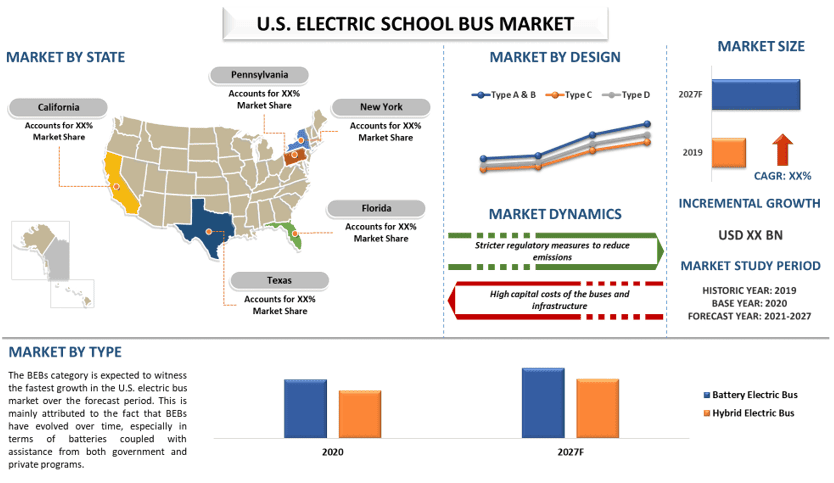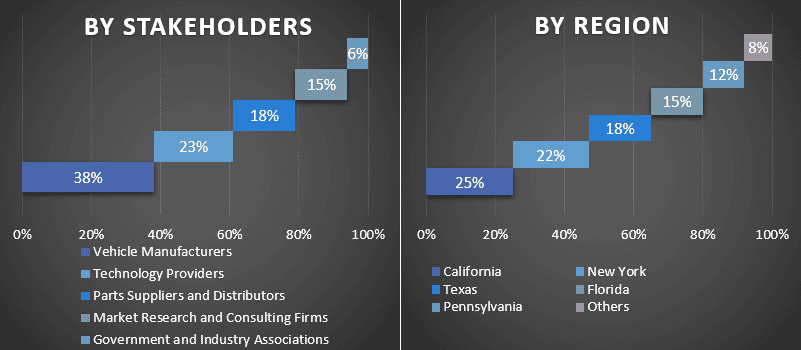- Home
- About Us
- Industry
- Services
- Reading
- Contact Us
U.S. Electric School Bus Market: Current Analysis and Forecast (2021-2027)
Emphasis on Design (Type A & B, Type C, and Type D); Type (Battery-electric buses and Hybrid electric buses); and States (California, New York, Texas, Florida, Pennsylvania, Others)

The U.S. electric school bus market is estimated to grow at a CAGR of around 25% during 2021–2027. This is mainly due to the implementation of stringent policies, coupled with the rising environmental awareness, which is encouraging the deployment of low- and zero-emission transport systems in the country. Furthermore, major electric bus manufacturers in the market are continuously opting for strategic measures such as partnerships and collaboration with technology providers to improve their product offerings. For instance, in 2020, Nuvve and Blue Bird announced their collaboration to introduce V2G-compatible electric buses to the U.S. market and more intelligently integrate electric vehicles (EVs) into the grid using Nuvve’s V2G platform. All Blue Bird Type C and D electric buses are manufactured with Nuvve’s V2G integration which, when combined with a Nuvve V2G charging station, are able to store and discharge energy.
The electric bus market has been significantly impacted by COVID-19. The entire ecology was disrupted, which led to a worldwide halt in the new electric bus’s manufacture and sales. OEMs’ operations were hampered by the need to delay manufacturing until lockdowns were lifted. The demand for automobiles in general, and electric vehicles (EVs) in particular, were hindered by the precautionary measures implemented by the federal and various state governments, such as complete lockdown and even curfew in hotspot locations. Significant commercial and financial disruptions in the EV business were triggered by COVID-19, which severely affected important American markets. However, the national, state, and local governments worked towards financial stability and provided support through regulations to encourage the purchase of low- or zero-emission vehicles (ZEVs). Thus, as a result of these reasons, the pandemic had little of an effect on the market for electric buses.
Blue Bird Corporation, The Lion Electric Co., BYD Motors Inc., GreenPower Motor Company Inc., Navistar International Corporation, Trans Tech Bus, Daimler AG, REV Group Inc., Starcraft Bus, and Micro Bird Inc. are some of the key players in the market. Several strategic measures have been undertaken by these players to facilitate customers with hi-tech and innovative products/technologies.
Insights Presented in the Report
“Amongst design, Type C category buses accounted for a significant share of the market in 2020”
Based on design, the market is bifurcated into Type A & B, Type C, and Type D. In 2020, Type C category buses accounted for a significant share of the market. Type C buses, typically carry up to a maximum of 60 and 72 students and tend to make longer trips than type A buses. Furthermore, almost every major manufacturer in the market offers a type C bus, giving school districts a variety of options. In addition, these manufacturers are continuously working on launching electric school buses with advanced and improved technology, offering higher distance range and running cost efficiency.
For instance, in 2018, Blue Bird Corporation unveiled its all-new Blue Bird Vision Electric Type C school bus at the NAPT conference in Columbus, Ohio. The electric powertrain is supplied by ADOMANI (ADOM), with drivetrain and vehicle control software developed and produced by their technology partner, Efficient Drivetrains Inc. (EDI). Blue Bird electric buses integrate the ADOMANI/EDI drivetrain and vehicle control software and telematics, delivering zero-emissions driving with outstanding vehicle performance and torque.
“Amongst type, BEBs category is expected to witness the fastest growth in the U.S. electric school bus market over the forecast period”
Based on type, the market is bifurcated into battery-electric buses and hybrid electric buses. The BEBs category is expected to witness the fastest growth in the U.S. electric school bus market over the forecast period. This is mainly attributed to the fact that BEBs have evolved over time, especially in terms of batteries coupled with assistance from both government and private programs. Additionally, most urban areas in the country experience air quality problems, which is prompting private and government transit agencies to purchase BEBs. In addition, major OEMs in the market are continuously developing and launching new and improved versions of BEBs in the market. For instance, in January 2022, BYD introduced a Type A battery electric vehicle in the U.S., equipped with innovative vehicle-to-grid technology, allowing the vehicle to serve as a power storage resource when it’s not transporting students.
Similarly, in March 2022, GreenPower Motor announced the launch of the Nano Beast: a purpose-built, battery-electric, Type A school bus with a range of up to 150 miles per charge.
“California to witness significant growth during the forecast period”
The Californian electric bus market accounted for the largest revenue share, in 2020, in the U.S. California is a leader in electric school bus adoption and has established many programs that assist school districts in purchasing these buses. The CEC School Bus Replacement Program is a $94 million program that replaces old school buses with electric buses in public school districts and county offices of education. In addition, a huge population demands efficient transportation systems. The California Air Resources Board (CARB), a subsidiary of the California EPA, aids the implementation of state-wide clean air standards by funding innovative emissions reduction projects, such as CARBS’ Hybrid and Zero-Emission Truck and Bus Voucher Incentive Project (HVIP). Furthermore, CARB’s HVIP operates similarly to NYTVIP, offering point-of-purchase rebate vouchers for eligible commercial vehicles, including electric school buses. CARB also manages the Rural School Bus Pilot Project that replaces older school buses in rural areas with clean vehicles, including electric school buses.
Reasons to buy this report:
- The study includes market sizing and forecasting analysis validated by authenticated key industry experts.
- The report presents a quick review of overall industry performance at one glance.
- The report covers an in-depth analysis of prominent industry peers with a primary focus on key business financials, product portfolio, expansion strategies, and recent developments.
- Detailed examination of drivers, restraints, key trends, and opportunities prevailing in the industry.
- The study comprehensively covers the market across different segments.
- Deep dive regional level analysis of the industry.
Customization Options:
U.S. electric school bus market can further be customized as per the requirement or any other market segment. Besides this, UMI understands that you may have your own business needs, hence feel free to connect with us to get a report that completely suits your requirements.
Table of Content
Research Methodology for the U.S. Electric School Bus Market Analysis (2021-2027)
Analyzing the historical market, estimation of the current market, and forecasting the future market of the U.S. electric school bus market were the three major steps undertaken to create and analyze the adoption of U.S electric bus in major regions globally. Exhaustive secondary research was conducted to collect the historical market numbers and estimate the current market size. Secondly, to validate these insights, numerous findings and assumptions were taken into consideration. Moreover, exhaustive primary interviews were also conducted, with industry experts across the value chain of the U.S. electric school bus market. Post assumption and validation of market numbers through primary interviews, we employed a top-down/bottom-up approach to forecasting the complete market size. Thereafter, market breakdown and data triangulation methods were adopted to estimate and analyze the market size of segments and sub-segments of the industry pertains to. Detailed methodology is explained below:
Analysis of Historical Market Size
Step 1: In-Depth Study of Secondary Sources:
Detail secondary study was conducted to obtain the historical market size of the U.S. electric school bus market through company internal sources such as annual reports & financial statements, performance presentations, press releases, etc., and external sources including journals, news & articles, government publications, competitor publications, sector reports, third-party database, and other credible publications.
Step 2: Market Segmentation:
After obtaining the historical market size of the U.S. electric school bus market, we conducted a detailed secondary analysis to gather historical market insights and share for different segments & sub-segments for major regions. Major segments included in the report as design and type. Further country-level analyses were conducted to evaluate the overall adoption of testing models in that region.
Step 3: Factor Analysis:
After acquiring the historical market size of different segments and sub-segments, we conducted a detailed factor analysis to estimate the current market size of the U.S. electric school bus market. Further, we conducted factor analysis using dependent and independent variables such as design and type of electric buses. A thorough analysis was conducted for demand and supply-side scenarios considering top partnerships, mergers and acquisitions, business expansion, and product launches in the U.S electric bus market sector across the globe.
Current Market Size Estimate & Forecast
Current Market Sizing: Based on actionable insights from the above 3 steps, we arrived at the current market size, key players in the U.S. electric school bus market, and market shares of the segments. All the required percentage shares split, and market breakdowns were determined using the above-mentioned secondary approach and were verified through primary interviews.
Estimation & Forecasting: For market estimation and forecast, weights were assigned to different factors including drivers & trends, restraints, and opportunities available for the stakeholders. After analyzing these factors, relevant forecasting techniques i.e., the top-down/bottom-up approach were applied to arrive at the market forecast about 2027 for different segments and sub-segments across the major markets globally. The research methodology adopted to estimate the market size encompasses:
- The industry’s market size, in terms of revenue (USD) and the adoption rate of the U.S. electric school bus market across the major markets domestically
- All percentage shares, splits, and breakdowns of market segments and sub-segments
- Key players in the S. electric school bus market in terms of solutions offered. Also, the growth strategies adopted by these players to compete in the fast-growing market
Market Size and Share Validation
Primary Research: In-depth interviews were conducted with the Key Opinion Leaders (KOLs) including Top Level Executives (CXO/VPs, Sales Head, Marketing Head, Operational Head, Regional Head, Country Head, etc.) across major regions. Primary research findings were then summarized, and statistical analysis was performed to prove the stated hypothesis. Inputs from primary research were consolidated with secondary findings, hence turning information into actionable insights.
Split of Primary Participants in Different Regions

Market Engineering
Data triangulation technique was employed to complete the overall market estimation and to arrive at precise statistical numbers of each segment and sub-segment of the U.S. electric school bus market. Data was split into several segments & sub-segments post studying various parameters and trends in the areas of design and type in the U.S. electric school bus market.
The main objective of the U.S. electric school bus market Study
The current & future market trend in the U.S. electric school bus market was pinpointed in the study. Investors can gain strategic insights to base their discretion on investment on the qualitative and quantitative analysis performed in the study. Current and future market trends determined the overall attractiveness of the market at a regional level, providing a platform for the industrial participant to exploit the untapped market to benefit as a first-mover advantage. Other quantitative goals of the studies include:
- Analyze the current and forecast market size of the U.S. electric school bus market in terms of value (USD). Also, analyze the current and forecast market size of different segments and sub-segments
- Segments in the study include areas of design and type.
- Define and analysis of the regulatory framework for the U.S. electric school bus market industry.
- Analyze the value chain involved with the presence of various intermediaries, along with analyzing customer and competitor behaviors of the industry.
- Analyze the current and forecast market size of the U.S. electric school bus market for the major region.
- Major states studied in the report include Asia California, New York, Texas, Florida, and Pennsylvania, among others.
- Company profiles of the U.S. electric school bus market and the growth strategies adopted by the market players to sustain in the fast-growing market
- Deep dive regional level analysis of the industry
Related Reports
Customers who bought this item also bought










